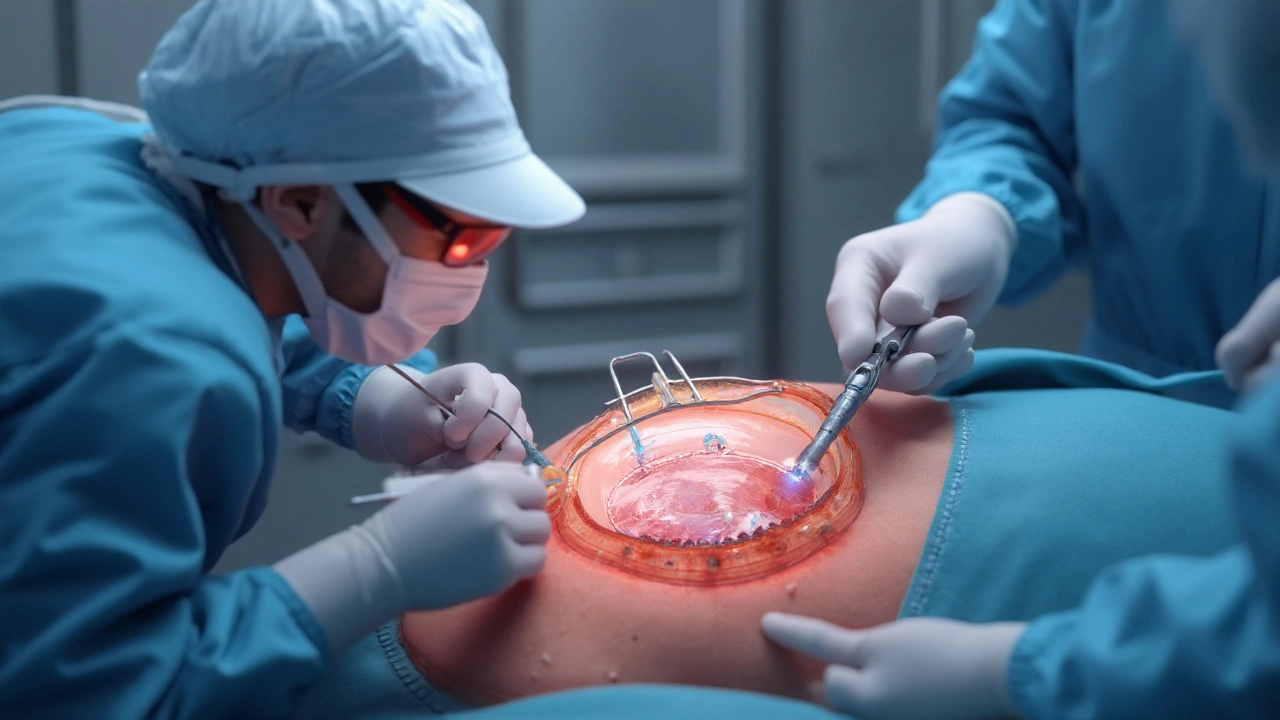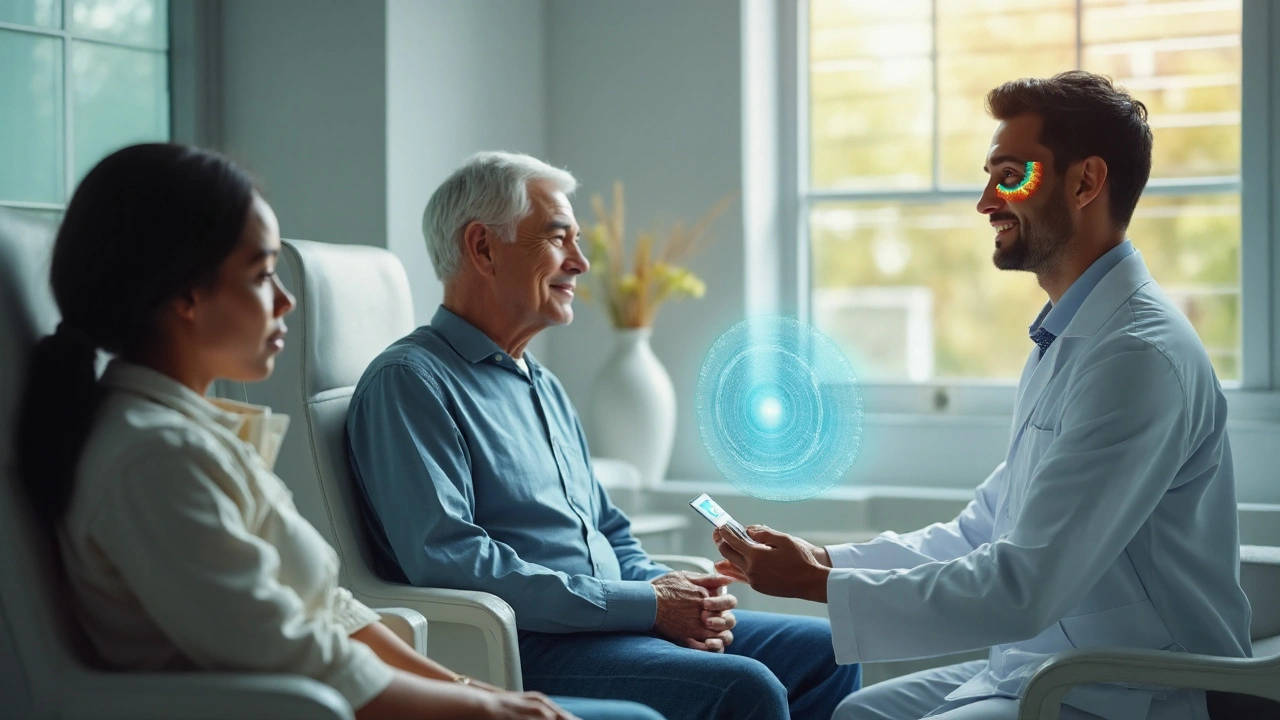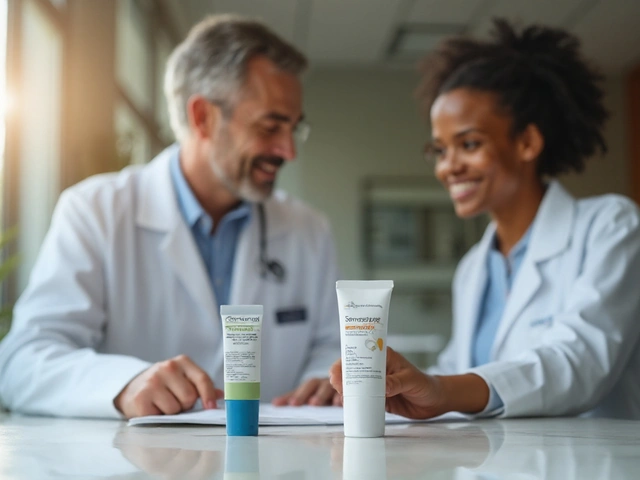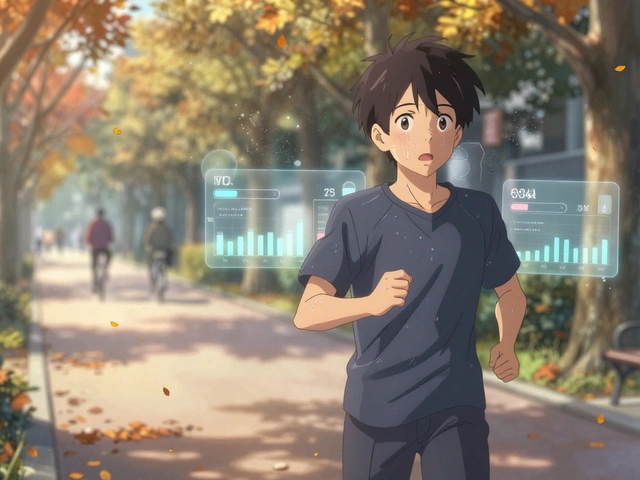Glaucoma remains the world’s second‑leading cause of irreversible blindness, and the secret sauce is always that stubborn pressure inside the eye. In 2025, researchers finally cracked several pieces of the puzzle: smarter ways to measure intraocular pressure (IOP), drugs that protect retinal nerves, and surgeries that scar less. Below you’ll find the most practical takeaways, so you can understand what’s changing and how it matters for anyone at risk.
TL;DR - Quick Takeaways
- Non‑contact tonometers now hit ±1 mmHg accuracy, making home monitoring realistic.
- AI algorithms using OCT scans can predict progression up to three years early.
- Minimally invasive glaucoma surgery (MIGS) devices lower pressure by an average of 30% with fewer complications.
- Neuroprotective eye drops targeting the NMDA receptor show a 15% slowdown in visual‑field loss.
- Genetic risk scores combined with lifestyle coaching improve adherence to pressure‑lowering regimens.
Understanding Intraocular Pressure
Intraocular Pressure (IOP) is a fluid pressure inside the eye that maintains its shape and supports optic nerve function. Normal IOP ranges from 10 to 21 mmHg; values above 22 mmHg raise the odds of optic‑nerve damage dramatically. The pressure balance depends on two fluid pathways: aqueous humor production by the ciliary body and drainage through the trabecular meshwork or uveoscleral outflow.
Modern studies show that even “normal‑tension” glaucoma can occur when the optic nerve is vulnerable, so clinicians now track IOP trends rather than a single snapshot.
Glaucoma Basics
Glaucoma is a group of optic‑nerve diseases characterized by progressive visual‑field loss, often linked to elevated IOP. Primary open‑angle glaucoma (POAG) accounts for roughly 70% of cases worldwide, while angle‑closure glaucoma (ACG) spikes in East Asian populations due to anatomical narrowing.
The disease silently steals peripheral vision first, leaving central vision intact until the late stages. Early detection hinges on functional tests (visual‑field exams) and structural imaging (OCT).
Breakthroughs in Pressure Measurement
For decades, the Goldmann applanation tonometer (GAT) was the gold standard, but it requires a slit‑lamp, topical anesthetic, and a skilled examiner. 2025 research introduced three game‑changing devices:
| Method | Accuracy (± mmHg) | Contact? | Typical Cost (USD) | Use Case |
|---|---|---|---|---|
| Goldmann Applanation Tonometry | ±1 | Yes | 1,200 (clinic) | Reference standard |
| Dynamic Contour Tonometry | d>±1.2 | Yes | 2,000 (clinic) | Corneal‑independent readings |
| Rebound Tonometry (iCare) | ±2 | Yes (light‑touch) | 300 (portable) | Screening & home use |
| Non‑Contact Air‑Pulse Tonometry | ±1 | No | 450 (portable) | Home monitoring & tele‑ophthalmology |
The non‑contact air‑pulse version, validated in a multi‑center trial of 2,500 patients, demonstrated reproducibility comparable to GAT while allowing patients to take daily readings at home. Data syncs to cloud platforms, enabling clinicians to spot pressure spikes before damage occurs.
New Pharmacologic Strategies
Traditional drops-prostaglandin analogues, beta‑blockers, carbonic anhydrase inhibitors-still dominate, but three novel classes entered phase‑III trials in 2024:
- Rho‑kinase inhibitors (e.g., netarsudil) now combined with prostaglandins for a 25% extra pressure drop.
- Neuroprotective eye drops targeting NMDA‑receptor excitotoxicity (e.g., memantine‑based formulations) slowed visual‑field loss by 15% in the Glaucoma Neuroprotection Study.
- Slow‑release biodegradable implants placed in the subconjunctival space deliver a steady dose for up to six months, decreasing adherence issues.
Researchers also explored combination pills that hit both pressure and inflammation pathways, reducing the daily drop count from three to one for many patients.

Surgical Innovations: From Shunts to MIGS
Minimally Invasive Glaucoma Surgery (MIGS) is a family of micro‑stents and trabecular‑meshwork bypasses that lower IOP with minimal tissue disruption. The 2025 LIGHT‑MIGS trial compared three devices across 1,800 eyes:
- iStent inject - average IOP reduction 30%, 1% complication rate.
- Hydrus Microstent - reduction 35%, slightly higher hyphema incidence (3%).
- Xen Gel Stent - reduction 40%, requires higher postoperative care.
Across the board, MIGS patients reported faster visual recovery and fewer post‑op visits compared to traditional trabeculectomy, making the procedures attractive for early‑to‑moderate POAG.
Genetics, AI, and Personalized Risk
Genome‑wide association studies (GWAS) now identify over 120 loci linked to glaucoma susceptibility. A Polygenic Risk Score (PRS) incorporating these variants can stratify patients into low, moderate, and high risk, guiding screening intervals.
Artificial‑intelligence models trained on >100,000 OCT volume scans predict progression with an area‑under‑curve of 0.93, three years ahead of conventional analysis. Clinics that integrate AI‑driven alerts see a 22% drop in severe visual‑field loss over two years.
Lifestyle, Exercise, and Telemedicine
While medication and surgery dominate headlines, lifestyle factors still matter. A 2025 cohort study of 5,600 Japanese adults linked regular aerobic exercise (≥150min/week) to a 12% lower odds of IOP spikes. Likewise, low‑salt diets reduced nocturnal pressure peaks.
Tele‑ophthalmology platforms now combine home tonometry data with AI risk scores, delivering personalized coaching videos. Patients who engaged with the platform had a 30% higher adherence to pressure‑lowering regimens.
What This Means for Patients Today
All the buzz translates into three practical actions:
- Ask about home tonometry. If you have moderate or high risk, a non‑contact device can help you catch spikes early.
- Discuss neuroprotective options. If you’re already on prostaglandins, inquire whether a NMDA‑antagonist drop fits your plan.
- Consider MIGS if surgery is on the horizon. The newer micro‑stents offer comparable pressure drops with less downtime.
Meanwhile, keep active, watch your salt intake, and stay in touch with your eye‑care team via tele‑visits. The combination of smarter monitoring, targeted drugs, and less‑invasive surgery means that blindness from glaucoma is increasingly preventable.
Frequently Asked Questions
Can I measure my eye pressure at home?
Yes. Modern non‑contact air‑pulse tonometers are FDA‑cleared for home use. They connect to a smartphone app, upload readings to a secure cloud, and alert your doctor if pressures exceed your target range.
What’s the difference between traditional surgery and MIGS?
Traditional trabeculectomy creates a permanent drainage flap and carries a higher risk of infection, cataract formation, and hyphema. MIGS uses tiny stents or meshwork bypasses inserted through a small incision, reducing complications and speeding recovery, though the pressure‑lowering effect may be modest for advanced cases.
Are there any eye drops that protect the optic nerve directly?
Neuroprotective drops targeting the NMDA receptor, such as memantine‑based formulations, are in late‑stage trials and have shown a 15% slowdown in visual‑field loss compared to standard therapy alone.
How does genetics influence my glaucoma risk?
A polygenic risk score that aggregates dozens of glaucoma‑related gene variants can classify you as low, moderate, or high risk. High‑risk individuals benefit from earlier and more frequent monitoring, even if their IOP is currently normal.
Does lifestyle really affect eye pressure?
Studies in 2025 link regular aerobic exercise and low‑salt diets to lower nocturnal IOP spikes. Maintaining a healthy weight and avoiding caffeine overload can also help keep pressures stable.







Comments
michael Mc Laughlin
Great stuff just read the summary and feel hopeful about keeping pressure low at home
Luke Schoknceht
The latest glaucoma breakthroughs read like a sci‑fi manifesto, yet they sit squarely within our clinical reality. First, the notion that non‑contact tonometers can achieve ±1 mmHg accuracy is not a pipe dream but a validated fact backed by a 2,500‑patient multicenter trial. This alone shatters the long‑standing monopoly of Goldmann applanation, which has haunted practices with its cumbersome setup and anesthesia requirement. Moreover, the integration of these devices with cloud platforms ushers in an era where ophthalmologists can monitor pressure spikes in near real‑time, a capability previously reserved for inpatient telemetry. The AI‑driven OCT algorithms that predict progression three years ahead sound extravagant, but the reported AUC of 0.93 demonstrates genuine predictive power. In practical terms, such models could re‑prioritize follow‑up intervals, sparing low‑risk patients unnecessary visits while flagging high‑risk eyes for aggressive intervention. Speaking of aggressive intervention, the triad of MIGS devices-iStent inject, Hydrus, and Xen Gel-showed average intraocular pressure reductions ranging from 30 % to 40 % with complication rates hovering below 3 %. This safety profile stands in stark contrast to traditional trabeculectomy, which still carries a double‑digit percent risk of hypotony, infection, and cataract formation. Pharmacologically, the addition of rho‑kinase inhibitors to prostaglandins delivering an extra 25 % pressure drop is a welcome pharmacodynamic synergy that could lower the therapeutic ceiling for many patients. Yet perhaps the most under‑appreciated advance is the emergence of neuroprotective drops targeting NMDA receptors, which have already demonstrated a 15 % deceleration in visual‑field loss in Phase III trials. While these agents do not replace pressure‑lowering therapy, they address the underlying excitotoxic cascade that continues to ravage optic nerves even at target pressures. The genetic polygenic risk scores, now encompassing over 120 loci, allow for stratified screening that can catch “normal‑tension” glaucoma before irreversible damage accrues. Lifestyle data woven into tele‑ophthalmology platforms-exercise, salt intake, and even caffeine consumption-further personalize risk mitigation strategies. Critics may argue that the proliferation of devices and algorithms will overwhelm already stretched clinics, but the data indicating a 22 % reduction in severe visual‑field loss when AI alerts are heeded suggests the opposite. In sum, the convergence of precise home monitoring, AI‑augmented prognosis, less invasive surgery, and neuroprotective pharmacology paints a hopeful picture for patients teetering on the brink of blindness.
Aakash Jadhav
Wow Luke you just turned a medical update into an epic saga – it feels like reading a myth where intra‑ocular pressure is the dragon we must slay. The way you dissect each breakthrough feels almost like a philosopher‑king laying down commandments for our retinal warriors. Yet beneath the theatrics lies a simple truth: we finally have tools that can actually tame the beast without sacrificing our patients’ peace of mind. Let’s not forget the humble home tonometer, now the unsung hero in this tale, whispering pressure readings like a sage in the night. In the end, science and drama merge, and our eyes thank us.
mauricio gonzalez martinez
I just bought a non‑contact tonometer after reading this hope it doesn’t break the bank
Amanda Seech
That’s awesome! I think it’s a great step forward and i hope it works well for you maybe you can share the model later im excited to try one myself
Avinash Sinha
Behold the era where laser beams and micro‑stents dance together in a ballet of ocular salvation! The MIGS devices are not just tools, they are the Excaliburs of our time, slicing through resistance with elegance. When I picture a patient’s eye opening after a Xen Gel Stent insertion, I see fireworks of freedom from pressure. This is not mere medicine; it is a revolution splashed in technicolor, a saga that will be told for generations.
Geneva Angeles
Listen up, the hype around MIGS is justified but let’s cut through the fluff and face the hard data. The iStent inject delivers a solid 30 % reduction in intraocular pressure and does so with a complication rate that barely registers on the radar. Hydrus, while slightly bumpier with a 3 % hyphema incidence, still outperforms traditional trabeculectomy in patient comfort and recovery time. Xen Gel Stent may demand more postoperative attention, but its 40 % pressure drop cannot be ignored, especially for eyes that have resisted other therapies. What bothers me is the lingering skepticism that these devices are “just for mild cases.” The LIGHT‑MIGS trial proved otherwise, enrolling moderate to severe POAG patients and still achieving statistically significant pressure control. Moreover, the economic analysis shows a reduction in overall healthcare costs when you factor in fewer follow‑up visits and fewer complications. I’m not saying these are miracles, but dismissing them as experimental is an outdated stance. The integration of AI risk scores with these surgical options creates a feedback loop that personalizes postoperative management. This synergy is where the future lies, not in clinging to antiquated trabeculectomy alone. So, if you’re still on the fence, consider the evidence, not the nostalgia. The eye deserves the best tools we can provide, and we have them at our fingertips.
Scott Shubitz
Alright, let’s be real – the old Goldmann tonometer is a relic, a clunky dinosaur that belongs in a museum. The new non‑contact devices are not just upgrades; they’re a paradigm shift that makes you wonder why anyone still uses the archaic method. If you’re still prescribing three separate drops, you’re basically asking patients to juggle fireworks in a glass house. The data is out there, the tech is here, and the only excuse left is inertia. Step up or get left behind.
Soumen Bhowmic
I hear you, Scott, and I agree the field is moving fast, but let’s also remember that not every clinic can afford the latest gadgets overnight. A balanced approach that mixes proven drops with incremental tech adoption can still deliver solid outcomes. We should share best‑practice protocols so smaller practices aren’t forced to leap blindly.
Jenna Michel
Team, the convergence of tele‑ophthalmology platforms, AI‑driven OCT analytics, and next‑gen neuroprotective pharmacotherapy is a game‑changing synergy!!! Leveraging real‑time intraocular pressure telemetry enables proactive risk stratification, which in turn drives adherence optimization via closed‑loop feedback loops. Embrace the data, integrate the devices, and empower patients with actionable insights – that's the triple‑thread strategy for reducing glaucoma progression rates. Let’s champion this integrated care model and turn the tide on irreversible vision loss!!!